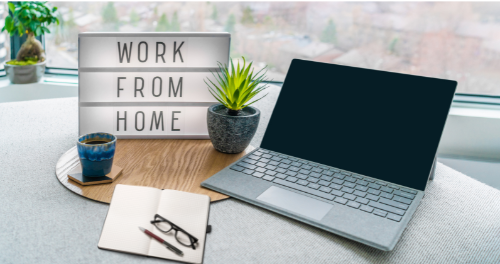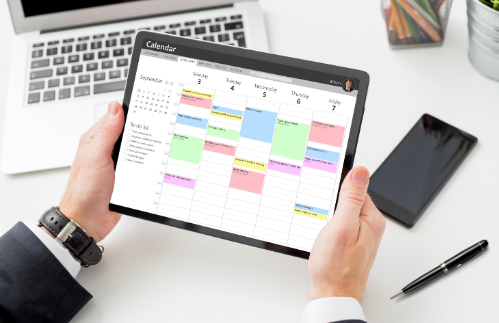How to Be More Productive at Home – 6 Areas of Focus for Proven Results

Ahhh, home sweet home! Isn’t it everyone’s dream to be able to work from the recliner in your living room?! Since you are reading this article it is apparent that working from home in some aspect has become a part of your life.
If you are like me, you have probably wondered how to be more productive at home. As a blogger, I work from home and have to be very intentional about how I manage my time to maximize my productivity!
With the recent COVID pandemic, we have seen a huge rise in individuals working from home. There has been a huge surge in the percentage of days worked remotely in the US rising from seven percent in 2019 to twenty-eight percent in 2023!
This rising trend of remote work offers flexibility but also poses challenges in maintaining productivity.
In this article, we will discuss six areas to focus on when improving your productivity at home. We will share practical productivity skills you can start using today!
Working from home can be convenient and provide you with more freedom and control of your time. Don’t let the convenience fool you though, the comforts of home can become distracting and pose several unique challenges. Issues like communication gaps, potential distractions at home, and difficulty in setting boundaries between work and personal life can impact overall efficiency.
Creating a Conducive Work Environment

As remote work becomes a staple in our professional lives, the significance of cultivating a conducive work environment at home cannot be overstated. The spaces we inhabit directly influence our productivity and well-being, making the creation of an optimal work setting imperative for success.
A Separate Room or Dedicated Workspace
The key to an effective work environment lies in the establishment of a dedicated workspace, preferably in a separate room. This separation delineates professional and personal spaces, helping maintain a clear boundary between work and leisure.
The psychological impact of having a designated area for work is profound, signaling the mind to focus on tasks when within that space and fostering a healthier work-life balance.
This is especially important when you have a family at home. It is nearly impossible to stay on task and be productive when you have your kids climbing all over you!
A designated room allows you to keep all your work materials and your mind organized.
Ergonomic Furniture for Postural Health
Investing in ergonomic furniture, such as standing desks and a nice office chair, is a game-changer for maintaining good posture and overall well-being.
A good ergonomic workstation can improve your productivity by 18%! That is a lot more work accomplished in a shorter amount of time just by simply investing in an ergonomic workstation!
The sedentary nature of remote work can take a toll on the body, leading to discomfort and fatigue. A standing desk not only encourages movement but also contributes to better blood circulation and increased energy levels.
Ergonomic chairs provide crucial support to the spine, reducing the risk of musculoskeletal issues and ensuring a comfortable and sustainable work experience.
Natural Light
Natural light is a key factor influencing mood and productivity. Just think about the difference you feel when you are working with sunlight as opposed to in a dark poorly lit cubical.
Positioning your workspace near a window not only floods the area with sunlight but also connects you with the external environment. Natural light has been linked to improved focus, reduced stress levels, and enhanced overall well-being.
Minimize Distractions
Minimizing distractions is equally vital for sustained productivity. Social media can be a big productivity killer. It is hard to stay focused when you are constantly checking your Instagram account!
It may be worth investing in a computer that is free of any apps that are not directly related to your work. Lock out all unnecessary apps on your phone during your designated work hours. Make it hard for yourself to get distracted.
Once you have created a good system of avoiding distractions it will become easy to stay productive! Selecting a quiet area away from high-traffic zones within the home ensures focus and concentration.
Fresh Air
Additionally, having the option to open windows for fresh air adds a revitalizing element to the work environment, promoting cognitive function and a sense of alertness.
If you need to brainstorm ideas for work, going on a walk outside can be a great way to get fresh air and really ramp up your brain’s ability to be creative for you!
Sometimes, I find the best solutions to problems I need to solve for work while I am outdoors. This is a unique advantage of working from home so utilize it when you can!
By prioritizing these aspects, you can create a productive haven at home, enhancing not only your professional output but also your overall quality of life.
Structuring Your Day

The freedom and flexibility to set your own schedule can be both a blessing and a challenge. Successfully navigating the nuances of working from home demands a strategic approach to daily routines.
Significance of a Morning Routine
Author Tim Ferriss once said that if you win the morning you win the day! I have definitely found that to be true!
The way you start your day sets the tone for the hours ahead. A morning routine isn’t just a series of activities; it’s a powerful tool to cultivate a positive mindset and prepare for the day’s tasks.
Whether it’s stretching exercises, meditation, or a healthy breakfast, these rituals act as mental triggers, signaling the transition from personal to professional time.
A well-crafted morning routine fosters a sense of purpose, helping you approach your work with clarity and enthusiasm.
As silly as it may sound the little things in the morning can truly make all the difference. Here a a few things that I like to do to start my day that are the key to how to be more productive at home.
- Prayer (this can also be any other form of spiritual refreshing you like to do)
- Shower
- Make my bed (success is in the small tasks!)
- Exercise (can be as simple as 10 jumping jacks or as much as a full-hour workout)
- Meditation (this allows you to clear your mind of all the clutter and prepare for ultimate productivity)
- Healthy breakfast
- Get hydrated! (your mind and body need water to function properly)
Maintaining a Regular Schedule
One of the challenges of working from home is the potential blur between work and personal life. Establishing and sticking to a regular schedule with clear work hours can help you stay productive.
Designate specific start and end times for your workday, and adhere to them diligently. This practice not only promotes discipline but also creates a clear boundary between your professional and personal spheres.
Setting these boundaries is crucial for preventing burnout, maintaining a healthy work-life balance, and ensuring you have time for relaxation and personal pursuits.
Having a set schedule like this creates expectations that you and your loved ones can rely on. In this way, you will have less discord in your home because everyone understands the boundaries.
This being said, one of the benefits of working from home is flexibility. Realize that it is ok to go to your son’s afternoon baseball game even though it is in the middle of your work day. Maybe you will just work a little later that day.
The Pomodoro Technique
In the battle against distractions and procrastination, the Pomodoro Technique can be a game-changer.
This time management method encourages working in focused intervals, typically 25 minutes, followed by a short break. After completing four cycles you then take a more extended break.
This approach optimizes your attention span, decreases mental fatigue, and breaks down tasks into manageable chunks. By segmenting your work, you not only maintain focus but also cultivate a heightened awareness of your progress throughout the day.
Several different apps are available to help you to implement the Pomodoro technique. Find your favorite and start implementing this strategy!
Managing Tasks and Priorities

The ability to manage tasks effectively is another key to being more productive at home. Whether you’re juggling multiple projects or navigating a complex workload, strategic task management and prioritization can make all the difference.
The Power of a To-Do List
A to-do list isn’t just a collection of tasks; it’s your roadmap to a productive day. Creating a comprehensive to-do list helps organize your thoughts, providing a visual representation of your goals and responsibilities.
Break down larger projects into actionable items, making them more manageable. As you check off completed tasks, you not only experience a sense of accomplishment but also maintain a clear overview of your progress.
Embrace digital tools or traditional pen and paper – the key is finding a method that resonates with you and supports your workflow.
Identifying and Prioritizing Tasks
Not all tasks are created equal, and recognizing the difference can significantly impact your efficiency.
Start by identifying the most critical and time-sensitive tasks. Consider factors such as deadlines, importance to overall goals, and potential impact on other projects.
Once identified, prioritize these tasks at the beginning of your workday when your energy and focus are at their peak. This proactive approach ensures that you tackle high-priority items with a fresh mind, setting a positive tone for the rest of the day.
Value of Meal Prep
Time is a precious commodity, especially when working from home. Incorporating meal planning and prep into your routine can save significant time during the work week.
Devote some time over the weekend to plan your meals for the week ahead, create a shopping list, and prepare ingredients. Having meals readily available minimizes the time spent on cooking and allows you to make healthier food choices.
Streamlining your meal-related tasks frees up valuable time that can be redirected towards work or much-needed breaks.
This tool helped us significantly during graduate school. We created a monthly menu and planned leftovers for meals that made lunches so much easier as well. Planning in this way eliminated a large amount of stress!
Balancing Professional and Personal Life

As the lines between professional and personal life blur when working from home, the importance of maintaining a harmonious balance cannot be overstated. Successfully navigating the challenges of working from home involves not only optimizing productivity but also fostering a healthy balance between work responsibilities and personal well-being.
Setting Boundaries with Family Members
One of the unique challenges of working from home is knowing how to handle the presence of family members.
While the convenience of proximity is undeniable, it’s essential to establish clear boundaries. Communicate your work hours and create designated spaces for professional tasks. By setting these expectations, you not only minimize interruptions but also create a structured environment conducive to focused work.
Respectful communication is key, ensuring that family members understand the importance of undisturbed work periods.
There will be fewer frustrations and arguments.
Having these set boundaries will allow you to stay productive with work and then still have time to do those house chores your wife needs you to do!
The ultimate goal is to create a wholesome living environment for the entire family! It will be easier to give your family the quality time they deserve when you organize your work with set boundaries!
Taking Breaks and Incorporating Physical Activity
A common pitfall in the remote work landscape is the tendency to work without breaks, leading to burnout and diminished productivity.
Recognizing the value of regular breaks is crucial. Incorporating short breaks throughout the day refreshes the mind, preventing fatigue.
Consider engaging in physical activities like a brisk walk or stretching exercises during these breaks. Not only does this boost physical well-being, but it also invigorates mental clarity. Schedule breaks strategically, allowing yourself moments of reprieve to recharge and return to work with renewed focus.
Hobbies and Quality Time with Loved Ones
Balancing work and personal life extends beyond the workday. Allocating time for hobbies or spending quality moments with loved ones is vital for overall well-being.
Engaging in activities you enjoy, whether it’s reading, painting, or playing an instrument, provides a mental escape from work-related stressors. Similarly, dedicating time to loved ones fosters emotional connections, contributing to a sense of fulfillment.
Striking this balance ensures that your life isn’t solely defined by work obligations, nurturing a holistic and satisfying lifestyle.
Being intentional about your time management will help you be more productive in every aspect of your life. You will be more motivated to work when you make sure to have quality time with your family and do activities you enjoy!
Leveraging Technology

In the digital age, technology serves an important role in remote work efficiency, offering tools to streamline tasks, enhance communication, and maintain a sense of connectedness. Leveraging these technological wonders is not just a convenience but a necessity for those navigating the challenges of working from home.
Staying Connected with Colleagues
Isolation can be a prevalent challenge in remote work, but technology provides solutions to bridge the gap. Social media channels and video calls have become indispensable tools for maintaining a sense of community within virtual teams.
Platforms like Slack, Microsoft Teams, or Zoom facilitate seamless communication, allowing colleagues to collaborate, share updates, and engage in discussions as if they were physically present. Video calls, in particular, add a personal touch, fostering a deeper connection by allowing face-to-face interactions, albeit virtually.
These tools not only enhance teamwork but also contribute to a positive work culture.
A word of caution, make sure to set boundaries with these tools or they might turn into distractions.
Productivity Apps for Task Management
Keeping track of tasks and deadlines can be overwhelming without the right tools.
Apps like Trello, Notion, Asana, or Todoist allow you to organize tasks, set priorities, and collaborate with team members effortlessly. These platforms facilitate transparency, ensuring everyone is on the same page regarding project timelines and progress.
Scheduling apps such as Google Calendar or Microsoft Outlook help you manage your time effectively by setting reminders for meetings, deadlines, and important tasks and milestones. By embracing these productivity apps, you not only enhance organization but also create a structured framework for your workday.
Maintaining Mental and Physical Health

To be more productive at home you have to make sure you are taking care of yourself mentally and physically. You don’t want to have toxic productivity. Your mind and body have to be in peak condition if you hope to maximize the work you get done. Just like your favorite sports car becomes useless without any fuel and regular maintenance you become useless without taking care of your personal needs.
Prioritizing Mental Health
The fast-paced nature of remote work can take a toll on mental health, making it essential to prioritize well-being. Integrating healthy habits into the daily routine is an effective strategy.
Start by incorporating mindfulness practices such as meditation or deep breathing exercises. These activities can be seamlessly woven into your morning routine or scheduled breaks, providing a mental reset amidst the demands of work.
Take regular breaks to step away from the screen, allowing moments of mental reprieve and preventing burnout. Recognizing the signs of stress and addressing them promptly is key to maintaining a positive and resilient mindset.
Regular Physical Activity and Breaks
Since working from home includes a lot of sedentary time, it becomes so important to find ways to get your body the physical exercise it needs to function.
Incorporating exercise into your routine not only contributes to physical well-being but also has profound effects on mental health. Whether it’s a brisk walk, a home workout, or yoga, physical activity releases endorphins, reducing stress and boosting mood.
Schedule breaks strategically, allowing time for short walks or stretching exercises. These breaks not only rejuvenate energy levels but also enhance focus and creativity. As mentioned, adopting the Pomodoro Technique can help you work in focused intervals and incorporate short breaks to maintain optimal productivity while preventing mental fatigue.
Conclusion
Working from home can be a great experience! You just have to be intentional about setting routines and strategies in place to help you be more productive.
Incorporating these productivity tips into your daily routine will help you have a more wholesome life in every aspect!
Set goals and make plans now! Make adjustments to your strategies as you go.
Know that learning how to be more productive at home will not happen on the first day. Give yourself some grace as you find a flow that fits best for you!
I have found an increased level of productivity in my work since implementing these strategies. It also makes for a happier home environment and who doesn’t want that?
Guest Post Authors: Alex and Jessica Morgan

Alex and Jessica are parents to three energetic boys! Jessica is a Registered Nurse and stay-at-home mom. Alex works as a Nurse Anesthesiologist. Together they run a parenting blog and love sharing their unique perspective on raising children.
Here’s some more career / job interview related help
- Tackling the final interview round
- How to answer ‘tell me about yourself’
- Interview questions for managers
- Do you need an Career coach / Interview coach?
- Career as a QA manager
- Project Management
- Managing Managers
- IT Career switch
- Software Engineering career path
Other posts that may interest you





